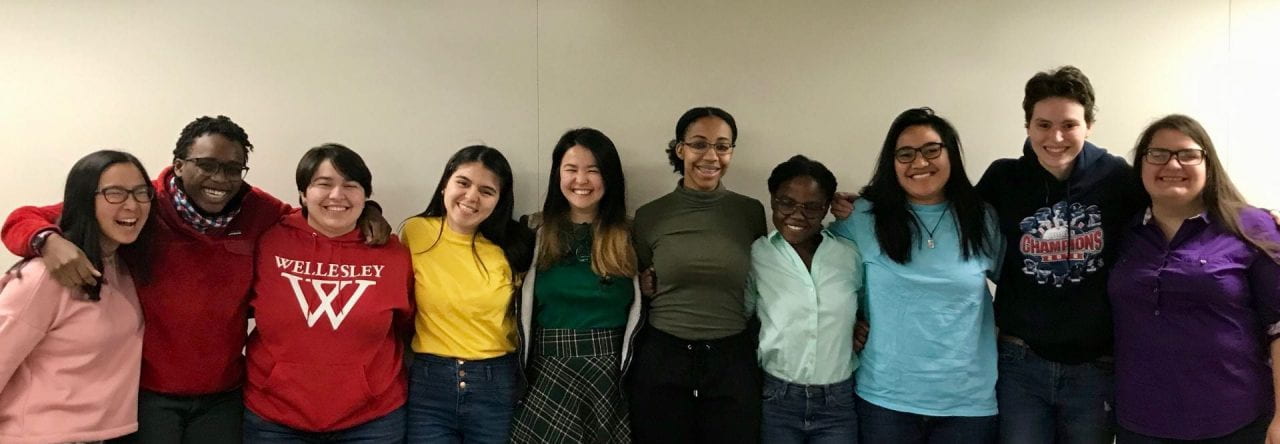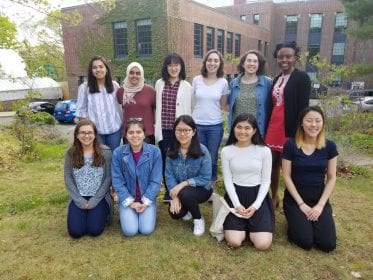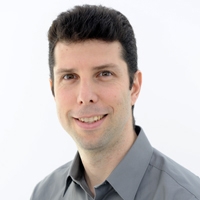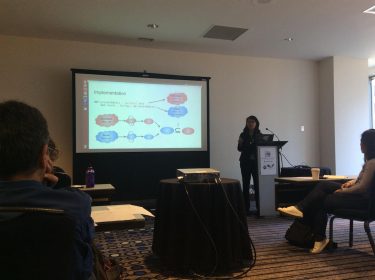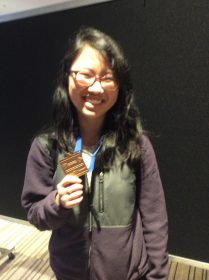CS Majors from the Class of 2018 presented their thesis work:
Eliza McNair ’18
adVantage – Seeing the Universe: How Virtual Reality can Further Augment a Three-Dimensional Model of a Star-Planet-Satellite System for Educational Gain in Undergraduate Astronomy Education
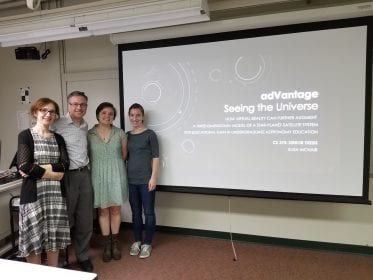 This thesis introduces the “adVantage – Seeing the Universe” system, a learning environment designed to augment introductory undergraduate astronomy education. The goal of the adVantage project is to show how an immersive virtual reality (VR) environment can be used effectively to model the relative sizes and distances between objects in space. To this end, adVantage leverages the benefits of three-dimensional models by letting users observe and interact with astronomical phenomena from multiple perspectives. The system uses pre-set vantage points to structure students’ progress through a variety of “missions” designed to improve their understanding of scale. The adVantage system departs from two-dimensional, textbook illustrations by adding navigable depths to a star-planet-satellite system, and distinguishes itself from existing pedagogical 3D space-simulation environments (that we know of) by establishing a laboratory for student investigation. Students exploring in adVantage will be able to observe the relative sizes and orbital movements of the subjects of the system: e.g., the exoplanet WASP-12b, its Sun-like star, WASP-12, and imagined satellites constructed to resemble the Earth and its Moon. This combination of astronomical bodies will engage students by introducing the new star-exoplanet system and provide context by incorporating familiar elements. We have already implemented a JavaScript prototype of the adVantage system and are developing the VR system using the game engine Unity and the VR system SteamVR. Students will interact with adVantage using a HTC Vive headset and hand controllers. We will carry out preliminary investigations of student response to the system when the immersive version of adVantage is complete.
This thesis introduces the “adVantage – Seeing the Universe” system, a learning environment designed to augment introductory undergraduate astronomy education. The goal of the adVantage project is to show how an immersive virtual reality (VR) environment can be used effectively to model the relative sizes and distances between objects in space. To this end, adVantage leverages the benefits of three-dimensional models by letting users observe and interact with astronomical phenomena from multiple perspectives. The system uses pre-set vantage points to structure students’ progress through a variety of “missions” designed to improve their understanding of scale. The adVantage system departs from two-dimensional, textbook illustrations by adding navigable depths to a star-planet-satellite system, and distinguishes itself from existing pedagogical 3D space-simulation environments (that we know of) by establishing a laboratory for student investigation. Students exploring in adVantage will be able to observe the relative sizes and orbital movements of the subjects of the system: e.g., the exoplanet WASP-12b, its Sun-like star, WASP-12, and imagined satellites constructed to resemble the Earth and its Moon. This combination of astronomical bodies will engage students by introducing the new star-exoplanet system and provide context by incorporating familiar elements. We have already implemented a JavaScript prototype of the adVantage system and are developing the VR system using the game engine Unity and the VR system SteamVR. Students will interact with adVantage using a HTC Vive headset and hand controllers. We will carry out preliminary investigations of student response to the system when the immersive version of adVantage is complete.
Valerie Zhao ’18
Evaluation of Dynamic Binary Instrumentation Approaches: Dynamic Binary Translation vs. Dynamic Probe Injection
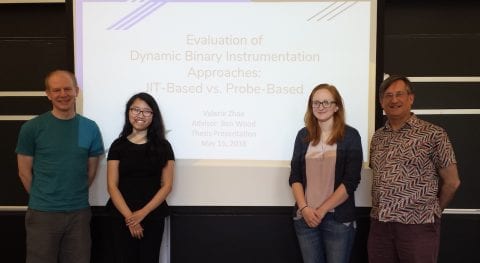 From web browsing to bank transactions, to data analysis and robot automation, just about any task necessitates or benefits from the use of software. Ensuring a piece of software to be effective requires profiling the program’s behavior to evaluate its performance, debugging the program to fix incorrect behaviors, and examining the program to detect security flaws. These tasks are made possible by instrumentation—the method of inserting code into a program to collect data about its behavior. Dynamic binary instrumentation (DBI) enables programmers to understand and reason about program behavior by inserting code into a binary during run time to collect relevant data, and is more flexible than static or source-code instrumentation, but incurs run-time overhead. This thesis attempts to extend the preexisting characterization of the tradeoffs between dynamic binary translation (DBT) and dynamic probe injection (DPI), two popular DBI approaches, using Pin and LiteInst as sample frameworks. It also describes extensions to the LiteInst framework that enable it to instrument function boundaries more effectively. Evaluations found that LiteInst performed up to 80× slower than the original binary run time, while Pin had at most 10× slow-down, suggesting that DBT is more efficient in some aspects.
From web browsing to bank transactions, to data analysis and robot automation, just about any task necessitates or benefits from the use of software. Ensuring a piece of software to be effective requires profiling the program’s behavior to evaluate its performance, debugging the program to fix incorrect behaviors, and examining the program to detect security flaws. These tasks are made possible by instrumentation—the method of inserting code into a program to collect data about its behavior. Dynamic binary instrumentation (DBI) enables programmers to understand and reason about program behavior by inserting code into a binary during run time to collect relevant data, and is more flexible than static or source-code instrumentation, but incurs run-time overhead. This thesis attempts to extend the preexisting characterization of the tradeoffs between dynamic binary translation (DBT) and dynamic probe injection (DPI), two popular DBI approaches, using Pin and LiteInst as sample frameworks. It also describes extensions to the LiteInst framework that enable it to instrument function boundaries more effectively. Evaluations found that LiteInst performed up to 80× slower than the original binary run time, while Pin had at most 10× slow-down, suggesting that DBT is more efficient in some aspects.
Maja Svanberg ’18
Suggested Blocks: Using Neural Networks To Aid Novice Programmers In App Inventor
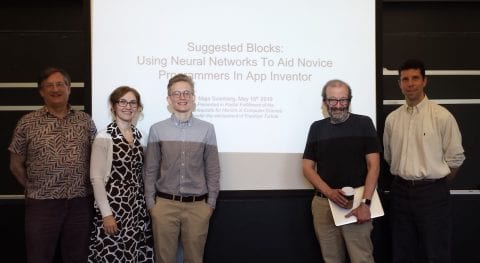 MIT App Inventor is a programming environment in which users build Android applications by connecting blocks together. Because its main audience is beginner programmers, it is important that users are given the proper guidance and instruction to successfully become creators. In order to offer this help, App Inventor provides text-based tutorials that describe the workflow of example programs to users. However, studies have shown that out-of-context help such as tutorials has little to no effect on learning, and when given the choice, users prefer in-context hints and suggestions. In order for users to overcome some of the barriers with self-training, we need to provide them with relevant information and in-context suggestions. Therefore, I am introducing Suggested Blocks, a data-driven model that leverages machine learning to provide users with relevant suggestions of which blocks to include in their programs.
MIT App Inventor is a programming environment in which users build Android applications by connecting blocks together. Because its main audience is beginner programmers, it is important that users are given the proper guidance and instruction to successfully become creators. In order to offer this help, App Inventor provides text-based tutorials that describe the workflow of example programs to users. However, studies have shown that out-of-context help such as tutorials has little to no effect on learning, and when given the choice, users prefer in-context hints and suggestions. In order for users to overcome some of the barriers with self-training, we need to provide them with relevant information and in-context suggestions. Therefore, I am introducing Suggested Blocks, a data-driven model that leverages machine learning to provide users with relevant suggestions of which blocks to include in their programs.
In this project, I focused on developing the neural networks to power a suggested blocks system. Using original apps from real App Inventor users, I developed a set of experiments to discover plausible vector representations of the data, including tree traversals, n-grams, tree structures, as well as different network architectures to generate the best possible block suggestions for the users. The objective is not only to be accurate, but to provide suggestions that are sensible, relevant, and most importantly, educational. When simulating the best model on reconstructing an original project from a novice user, suggesting only 10 blocks at a time, the user would be able to drag- and-drop 60% of her blocks straight form the Suggested Blocks drawer. Overall, the results show promise for a future implementation of a Suggested Blocks system.
